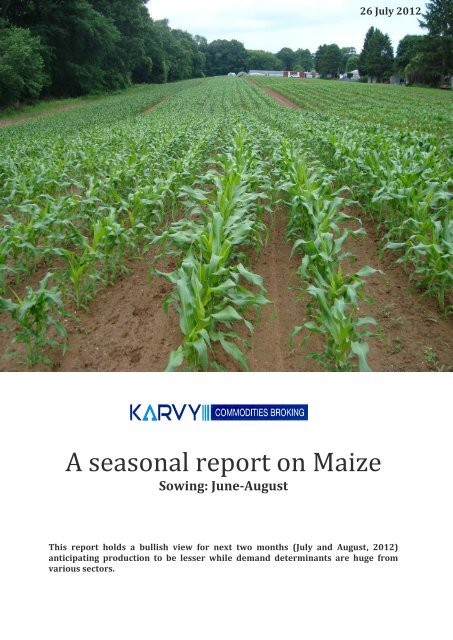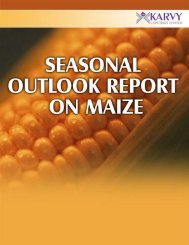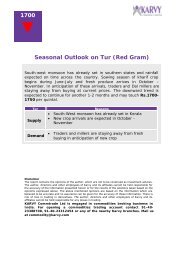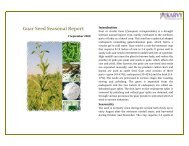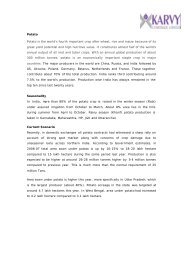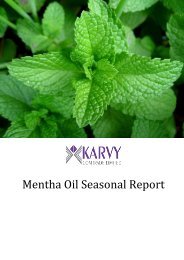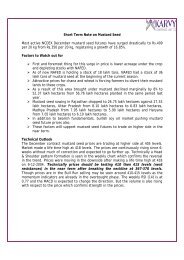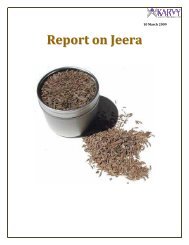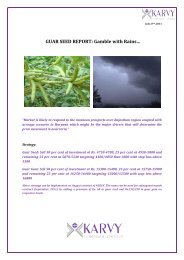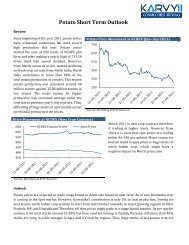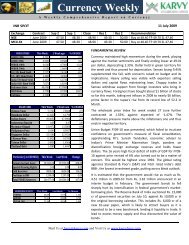A seasonal report on Maize - Karvy Commodities Broking
A seasonal report on Maize - Karvy Commodities Broking
A seasonal report on Maize - Karvy Commodities Broking
Create successful ePaper yourself
Turn your PDF publications into a flip-book with our unique Google optimized e-Paper software.
26 July 2012A <str<strong>on</strong>g>seas<strong>on</strong>al</str<strong>on</strong>g> <str<strong>on</strong>g>report</str<strong>on</strong>g> <strong>on</strong> <strong>Maize</strong>Sowing: June-AugustThis <str<strong>on</strong>g>report</str<strong>on</strong>g> holds a bullish view for next two m<strong>on</strong>ths (July and August, 2012)anticipating producti<strong>on</strong> to be lesser while demand determinants are huge fromvarious sectors.
Introducti<strong>on</strong><strong>Maize</strong> is basically a cereal crop. It is also known as corn and mostly grown as a rainfed crop. It isc<strong>on</strong>sumed as a staple food in many countries like South America, sub Saharan Africa, Kenya. The cropseas<strong>on</strong> in India generally begins in the m<strong>on</strong>th of mid May and c<strong>on</strong>tinues until June end. In India, the majorproducers are Karnataka, Andhra Pradesh, UP, Bihar, Punjab, and Tamil Nadu. The major producers in theworld are US, China, Brazil, Mexico, India and c<strong>on</strong>suming countries are China, USA.Crop seas<strong>on</strong>sGlobally maize is grown in all seas<strong>on</strong>s and hence, is available throughout the year. The crop seas<strong>on</strong>s ofChina, India and United States are same i.e. summer m<strong>on</strong>ths of April and May. On the other hand, Rabi cropof India starts just few days after the harvesting of crop in China, US. Hence, <strong>Maize</strong> is grown practicallythroughout the year in India. India can make use of this <str<strong>on</strong>g>seas<strong>on</strong>al</str<strong>on</strong>g>ity pattern to supply the produce to thecountries which are in demand of <strong>Maize</strong>. Sowing in Brazil starts in August. Indian Rabi seas<strong>on</strong> sowing startsby October and harvest takes place in February- March.COUNTRYIndia KharifIndia RabiU.SChinaMexicoArgentinaBrazilSouth AfricaSOWINGMAIZE (MAKKA)JAN FEB MAR APR MAY JUN JUL AUG SEP OCT NOV DECHARVESTING<strong>Maize</strong> Prices PerformancePrice review of <strong>Maize</strong> from 2008-1217001600Weather c<strong>on</strong>cerns,inadequate sowing15001400130012001100wide mismatchbetween demand& supply, highpoultry demandHigher domestic andexport demandself sufficiency inproducti<strong>on</strong>,increased SRR, NTAs,Huge demand , lessarrivals1000900800700Global recessi<strong>on</strong>Good crop, recordproducti<strong>on</strong> levels60005-01-2008 05-01-2009 05-01-2010 05-01-2011 05-01-2012Sources: Bloomberg & KCTL Research
In the initial m<strong>on</strong>ths of the year 2008, prices were very much low due to global recessi<strong>on</strong> because of whichthe demand went down. However, during later m<strong>on</strong>ths maize prices move up due to the mismatch betweenthe demand and supply and higher poultry demand. The producti<strong>on</strong> was quite good in the year 2009-10because of various reas<strong>on</strong>s like self sufficiency in producti<strong>on</strong>, increased SRR (Seed Replacement Rate),increase in acreage of NTAs (N<strong>on</strong> Traditi<strong>on</strong>al Areas). Due to the higher supplies during Rabi seas<strong>on</strong> maizeprices fell drastically during initial m<strong>on</strong>ths of 2010. Subsequently, higher domestic and export demandsupported maize prices to recover and prices at NCDEX touched its yearly high. In year 2011, producti<strong>on</strong>was very good c<strong>on</strong>tributing 21,300 metric t<strong>on</strong>nes which resulted in huge fall in maize prices. However, inthe beginning of the year 2012, prices went up because of huge demand and less arrivals. Prices in them<strong>on</strong>ths of July 2012 made a new all time of Rs. 1640 per quintal at NCDEX Platform because of weatherc<strong>on</strong>cerns which has affected sowing to a large extent. The anticipated crop loss due to unfavourableweather is keeping maize prices firm.Factors Affecting <strong>Maize</strong> PricesIt has wide applicati<strong>on</strong>s in various fields; it is c<strong>on</strong>sumed as such after boiling, in fried form, poultry andcattle feed, bio-ethanol producti<strong>on</strong>, producti<strong>on</strong> of industrial products like starch, protein etc. Prices dependbasically <strong>on</strong> the demand and supply factors, inventory levels, current producti<strong>on</strong> levels, prices of related orsubstitute products like Soybean, domestic and internati<strong>on</strong>al demand, c<strong>on</strong>sumpti<strong>on</strong> levels of meat, Govt.interventi<strong>on</strong>s like MSP etc. Diversi<strong>on</strong> of crop for purposes other than food producti<strong>on</strong> (fuel) also leads toincrease in prices.Global scenarioWE and China are the largest maizeproducer in world followed by EU-27,Brazil and India. According to theseas<strong>on</strong> of the crop, the produce ofIndia arrives in the market at thesame time as that of the topproducers like United States, China,and European Uni<strong>on</strong> etc. HenceUnited States and India will haveenough surplus to supply to the worldand cater to the need of importingnati<strong>on</strong>s thus satisfying the food, feedand industrial sector demand. Thewinter crop of India arrives in themarket at the time after which theproduce of Brazil also enters themarket.India has an upper hand in supplyingthe produce to the world markets since it has a dual crop seas<strong>on</strong>. So in case of any problem due toproducti<strong>on</strong> or climatic c<strong>on</strong>cerns in Brazil, India will be in a positi<strong>on</strong> to supply to the demanding countries.World balance sheetGlobal <strong>Maize</strong> producti<strong>on</strong> is growing at the CAGR of 4.35% for the past five years and c<strong>on</strong>sumpti<strong>on</strong> by4.07%. Most of the global demand is estimated to be driven by China because of its increasing Hog herd,poultry populati<strong>on</strong>.Years Total Supply (Milli<strong>on</strong> T<strong>on</strong>s) Total Demand (Milli<strong>on</strong> T<strong>on</strong>s)Beginning stocks Imports Producti<strong>on</strong> Exports C<strong>on</strong>sumpti<strong>on</strong> Ending stocks2008-09 131.608 82.639 801.160 84.486 782.840 148.0812009-10 148.081 90.183 819.364 96.858 816.850 143.9202010-11 143.920 92.602 829.115 91.392 849.927 124.3182011-12 124.318 93.975 872.983 96.407 865.679 129.1902012-13* 129.190 100.316 949.933 105.322 918.379 155.738Source: USDA estimates (* projected)<strong>Maize</strong> Producing countries in worldIndia2%Ukraine3%EU7%Brazil8%Others22%Sources: USDA & KCTL Researchchina22%US36%
According to USDA, producti<strong>on</strong> & c<strong>on</strong>sumpti<strong>on</strong> for year 2012-13 is expected to increase by 9% and 6%respectively, hence adequate supplies will be there for exports. Therefore, lower imports and higherexports are projected for 2012-13. However, 6% of crop got damaged due to La Nina.Major Importers & Exporters of <strong>Maize</strong> in WorldThe largest maize importer in World is Japan followed Mexico, South Korea followed by EU-27, China.European Uni<strong>on</strong> can import from United States since enough supplies are projected.United States is the largest maize exporter in world followed by Argentina, Ukraine and Brazil. Thedestinati<strong>on</strong> for exports are slightly different compared to the previous years. India and Ukraine has acompetitive advantage in maize exports to China due to lower prices as compared to US and good supplies.As per the 2011-12 estimates, the top exporters of <strong>Maize</strong> in the world are United States (South America),Argentina, Ukraine and Brazil. The major countries that import maize are Japan, Mexico, South Korea andChina but by the end of the year 2014, China is expected to become the top importer of maize in the worlddue to the c<strong>on</strong>tinuously increasing demand from the feed industry which is more than 61% of the totaldemand.Major <strong>Maize</strong> ImportersMajor <strong>Maize</strong> ExportersOther41%China Egypt5% 5% EU-276%Iran4%Japan16%Others11%Argentina15%Brazil13%EU-273%Taiwan5%Mexico10%Korea,South8%UnitedStates41%Ukraine14%India3%Source: USDA & KCTL Research<strong>Maize</strong> Balance Sheet- CHINATotal Supply (Milli<strong>on</strong> T<strong>on</strong>s)Total Demand (Milli<strong>on</strong> T<strong>on</strong>s)Years BeginningstocksImports Producti<strong>on</strong> Exports C<strong>on</strong>sumpti<strong>on</strong> Endingstocks2011-12 49.415 5 192.780 0.2 188.000 58.9952012-13* 58.995 7 195.000 0.2 201.000 59.795Source: USDA estimates (* projected)As per USDA estimates, producti<strong>on</strong> is expected to increase by 1% and c<strong>on</strong>sumpti<strong>on</strong> by 7%. This widemismatch between the demand and supply will arise due to the ever increasing populati<strong>on</strong>, increasing percapita meat c<strong>on</strong>sumpti<strong>on</strong> and hence feed demand apart from industrial demand for starch, corn syrup andother processed products. Producti<strong>on</strong> is stagnant; productivity is not increasing compared to the area. Eventhough the beginning stocks are more by 19%, it is expected that the demand will not match with thesupply due to increasing c<strong>on</strong>sumpti<strong>on</strong>. In the 2010 crop year, around 70 t<strong>on</strong>s of every 100 t<strong>on</strong>s of cornused in China were used for feed. China’s Corn producti<strong>on</strong> in 2010 decreased by 13% to a four year lowdue to drought and hence China became an importer of corn from 2010 from being an exporter. Cornimports are taking place apart from soybean imports. For the first time, China has started importing cornfrom Ukraine due to lower cost than US and it is n<strong>on</strong> genetically modified crop. So, Chinese firms are able toprocure the raw materials in abundance at cheaper rates to fulfil all their demands. While, imports areexpected to increase by 40% Y/Y. Previously, it was dependent <strong>on</strong> United States entirely for its supply. But
now, China has become aware of its import needs, hence it is diversifying the supply sources. It has signed asanitary protocol for supply of quality corn with Argentina in March 2012.<strong>Maize</strong> Balance Sheet- UNITED STATESYears2011-12Total Supply (Milli<strong>on</strong> T<strong>on</strong>s)Total Demand (Milli<strong>on</strong> T<strong>on</strong>s)BeginningstocksImports Producti<strong>on</strong> Exports C<strong>on</strong>sumpti<strong>on</strong> Endingstocks28.644 0.508 313.918 41.912 279.540 21.6182012-13* 21.618 0.381 375.683 48.262 301.639 47.781Source: USDA estimates (* projected)Producti<strong>on</strong> will improve due to improved technology and change in cultivati<strong>on</strong> practices. Producti<strong>on</strong> isslated to increase at a faster rate of 20% compared to c<strong>on</strong>sumpti<strong>on</strong> rate of 8% mainly due to increasedacreage. Few areas got damaged due to high temperature but it is expected that it will rain in the next 2-3weeks which will compensate for the loss. The number of feed grain farms has decreased but acreage percorn farm has improved and number of large corn farms has increased over time. Most of the domesticdemand is due to increasing Latin American populati<strong>on</strong>, food use, fuel use in the form of ethanol. Almost30% of the corn producti<strong>on</strong> goes towards producti<strong>on</strong> of ethanol since 180 corn based ethanol plants arethere in U.S. Hence adequate supplies are expected to be there to meet the demand arising from varioussectors. Exports are supposed to increase by 15%. Heat waves are predicted to affect the export of corn toEuropean Uni<strong>on</strong>. Even though the beginning stocks are estimated to be less by 25%, enough producti<strong>on</strong> isprojected for supply. Hence, corn trade prospects are very good compared to other countries like China.<strong>Maize</strong> Balance Sheet: EUROPEAN UNIONYearsTotal Supply (Milli<strong>on</strong> T<strong>on</strong>s)Total Demand (Milli<strong>on</strong> T<strong>on</strong>s)BeginningstocksImports Producti<strong>on</strong> Exports C<strong>on</strong>sumpti<strong>on</strong> Endingstocks2011-12 4.923 5.500 64.636 2.70 67.0 5.3592012-13* 5.359 7.0 64.150 2.0 69.5 5.009Source: USDA estimates (* projected)Producti<strong>on</strong> is expected to decrease by 1% whereas c<strong>on</strong>sumpti<strong>on</strong> is expected to increase by 4%. Hence, EUhas to import corn from other countries. Imports are projected to increase at the same rate as that of theincrease in exports. Even though the beginning stocks are more, still the country has to import from otherproducers because of increasing demand from various sectors like feed, residual use. As menti<strong>on</strong>ed in theabove paragraph, the country has to import corn from countries like United States, Brazil or othercountries.<strong>Maize</strong> Balance Sheet: BRAZILYearsBeginningstocksTotal Supply (Milli<strong>on</strong> T<strong>on</strong>s)Total Demand (Milli<strong>on</strong> T<strong>on</strong>s)Imports Producti<strong>on</strong> Exports C<strong>on</strong>sumpti<strong>on</strong> Ending stocks2011-12 10.276 0.8 69.0 12.0 54.0 14.0762012-13* 14.076 0.8 67.0 12.0 56.0 13.876Source: USDA estimates (* projected)It is expected that the producti<strong>on</strong> will decrease at the rate of 3% compared to c<strong>on</strong>sumpti<strong>on</strong> which will growat the rate of 4%. The country can manage without importing the produce since enough carry over stocks ofthe previous year are available to fulfil the demand. The beginning stocks have increased by almost 37%.Hence, the rate of import is estimated to be c<strong>on</strong>stant compared to the last year. Poultry demand hasincreased by around 3%. Compared to the previous year, c<strong>on</strong>sumpti<strong>on</strong> is expected to be more than theproducti<strong>on</strong> due to increased industrial use compared to feed use and increased c<strong>on</strong>sumpti<strong>on</strong> of processedproducts like corn syrup.
<strong>Maize</strong> Balance Sheet: UKRAINETotal Supply (Milli<strong>on</strong> T<strong>on</strong>s)Total Demand (Milli<strong>on</strong> T<strong>on</strong>s)Years BeginningstocksImports Producti<strong>on</strong> Exports C<strong>on</strong>sumpti<strong>on</strong> Endingstocks2011-12 1.121 0.05 22.838 14.0 8.8 1.2092012-13* 1.209 0.05 24.0 14.0 9.3 1.959Source: USDA estimates (* projected)The scenario in Ukraine has underg<strong>on</strong>e a major change. Producti<strong>on</strong> is projected to increase by 5% butc<strong>on</strong>sumpti<strong>on</strong> still further by 6%. Still Ukraine can manage without increasing its imports due to sufficientcarryover stocks from the last year which increased by 8%. It is expected to overtake Argentina as world’ssec<strong>on</strong>d largest corn exporter due to the prevailing drought c<strong>on</strong>diti<strong>on</strong>s in Argentina. Since China became anet importer from exporter a few years back, countries have turned to Ukraine for supply of Corn. Due torising demand and good profitability, usable area has increased sharply in recent years. Japan startedpurchasing from Europe since US offered at a much higher price and most of this European Corn wasshipped to Japan from Ukraine. Because of adequate supplies last year, the prices were pulled down after ithit a record high in June last year.Indian Scenario<strong>Maize</strong> in India is grown both as akharif and Rabi crop. It is grown as aKharif crop in north India and insouth; it is grown during the m<strong>on</strong>thsof April- October mostly as a wintercrop. Most of the crop is grown as akharif crop; it is sown during them<strong>on</strong>th of May and harvested in them<strong>on</strong>ths of Sep-Oct. India’sc<strong>on</strong>tributi<strong>on</strong> to the world producti<strong>on</strong>is hardly 2% but it plays a major rolein trading with other countries. Areaunder <strong>Maize</strong> producti<strong>on</strong>, productivityand yield kept <strong>on</strong> increasing til 2010after which it started declining due toshifting of acreage towards moreprofitable crops. Andhra Pradesh isthe largest producer of <strong>Maize</strong><strong>Maize</strong> Producing States in Indiaothers35%Bihar9%Maharashtra9%Sources: USDA & KCTL ResearchAP21%Rajasthan10%Karnataka17%c<strong>on</strong>tributing around 21% of the total producti<strong>on</strong> followed by Karnataka (16.5%), Rajasthan (9.9%),Maharashtra (9%) and Bihar (8.9%). The major physical markets are Nizamabad, Davangere. Am<strong>on</strong>g theIndian states, Rajasthan has the largest area under maize cultivati<strong>on</strong>.C<strong>on</strong>sumpti<strong>on</strong> patternMost of the <strong>Maize</strong> in India is used in poultryfeed industry as it is growing at the rate of 12-15% annually. Apart from this, the produce alsogoes towards feeding the cattle, producti<strong>on</strong> ofstarch and other value added products like cornsyrup, corn oil, corn flakes, soups etc. Around52% of the demand is projected from poultryfeed and the remaining 48% is from others likehuman c<strong>on</strong>sumpti<strong>on</strong> and processing sector.<strong>Maize</strong> C<strong>on</strong>sumpti<strong>on</strong> pattern in IndiaOthers27%Poultry48%Strach11%Sources: USDA & KCTL ResearchLivestock14%
<strong>Maize</strong> balance sheet: INDIA<strong>Maize</strong> producti<strong>on</strong> in India in the last five years has grown at a CAGR of 3.79% and c<strong>on</strong>sumpti<strong>on</strong> by 8.94%respectively. This demand supply gap is because of increasing domestic poultry demand.Years Total Supply (Milli<strong>on</strong> T<strong>on</strong>s) Total Demand (Milli<strong>on</strong> T<strong>on</strong>s)Beginning Imports Producti<strong>on</strong> Exports C<strong>on</strong>sumpti<strong>on</strong> EndingstocksStocks2007-08 0.322 0.004 18.96 4.47 14.20 0.6132008-09 0.613 0.013 19.73 2.60 17.0 0.7482009-10 0.748 0.024 16.72 1.93 15.10 0.4532010-11 0.453 0.025 21.73 3.50 18.10 0.6082011-12 0.608 0.01 21.30 2.40 18.80 0.7182012-13* 0.718 0.01 22.0 2.20 20.0 0.528Source: USDA estimates (* projected)Indian maize producti<strong>on</strong> is expected to increase by 3% but c<strong>on</strong>sumpti<strong>on</strong> by 6% in 2012-13. This mismatchin supply demand is likely to keep maize prices <strong>on</strong> firm note during 2012-13. Exports are projected todecline by around 8% Y/Y due to excess domestic demand from different sectors like poultry, feed, andindustries. Because of poor sowing in major growing states like Karnataka, Andhra Pradesh, andMaharashtra due to insufficient and delayed rainfall, increasing demand from poultry sector, maize pricesare expected to rise in the coming year 2012-13.Apart from the cash incentives being provided by the major growing states, minimum support pricesannounced by the Government is encouraging and boosting the cultivati<strong>on</strong> of maize to a large extent. Themain driving force for the demand is the increased requirement from the industrial sector.Kharif seas<strong>on</strong> sowing progressAs it is known to us that Indian Agriculture is a gamble of M<strong>on</strong>so<strong>on</strong>s, productivity and overall yield of anycrop depends up<strong>on</strong> the weather c<strong>on</strong>diti<strong>on</strong>s. Because of the diminishing rainfall, sowing is getting hamperedin many parts of the country especially the major growing areas of <strong>Maize</strong> like Andhra Pradesh, Karnataka,Rajasthan and Maharashtra. M<strong>on</strong>so<strong>on</strong> has not been good so far. Until July 11 th , rainfall received is 22%below than L<strong>on</strong>g Term Average (LPA) and the northern states experienced deficit of rainfall to a majorextent. Now let us see how far sowing has progressed in the major cultivating regi<strong>on</strong>s.Andhra Pradesh- Until now, 51% sowing has been completed so far. 2.55 lakh ha sowing has been finishedwhich is higher than last year’s sowing of 2.11 lakh ha but lower compared to the normal sown area of 2.87lakh ha.Karnataka- The average rainfall in north Karnataka is 111cm and deficient by 37 cm which has badlyaffected sowing. Hence, sowing is not started in north districts like Dharwad, Bagalkot, Gadag and Bijapur.It is expected to pick up <strong>on</strong>ce the m<strong>on</strong>so<strong>on</strong> resumes.Rajasthan – Sowing has been completed in East Rajasthan because of sufficient rainfall. Only 39 cm rainfallhas been received till date in western Rajasthan which has affected sowing.Bihar- Because of scanty rains and weak m<strong>on</strong>so<strong>on</strong>, sowing has not been started.Gujarat- 5% sowing is completed in southern regi<strong>on</strong> of Saurashtra. It c<strong>on</strong>tinues at a good speed in Navsariand Anand regi<strong>on</strong>s. North Gujarat could not start sowing because of weather c<strong>on</strong>cerns.Maharashtra- Sowing could not be d<strong>on</strong>e in Sangli, Satara, Pune and Solapur because of inadequate rainfallin the middle regi<strong>on</strong> of Maharashtra.
Indian <strong>Maize</strong> Export ScenarioThe major export destinati<strong>on</strong>s for India are UAE,Middle East, South Asia, Singapore, and Malaysia.The exports have been declining for the past twoyears and projected to decline further in 2012-13due to more domestic poultry demand. However,overall the export scenario is very goodcompared to other <strong>Maize</strong> suppliers. India has arelative price and locati<strong>on</strong> advantage. India is in abetter positi<strong>on</strong> to export the produce since theproduce is 25% cheaper compared to US anddistance to the importing countries is less, thusreducing the freight charges. Malaysia, Ind<strong>on</strong>esiaand Thailand are the main buyers. India is likelyto export around 10% of its total produce in2012-13.Competitive advantage of Indian <strong>Maize</strong> exportsDemand for Indian maize from south eastern countries is likely to pick up as prices are lower as againstthat of the US corn. <strong>Maize</strong> prices in US are ruling high because of dry weather c<strong>on</strong>diti<strong>on</strong>s thereby turning anadvantage for Indian maize exports. The price is cheaper and delivery is faster in comparis<strong>on</strong> to othersuppliers. The voyage i.e. distance to Asian markets is lesser compared to other suppliers and hencelogistics cost involved is less.Proximity to the importing countries is an added advantage. Importing countries like Australia which usedto purchase from US and China has switched over to India because of the proximity and cheaper cost.Indian corn is available at US$310/ t<strong>on</strong>ne for South East Asia whereas Argentine corn is quoted at US$ 340/t<strong>on</strong>ne thereby leading to competitive advantage. Farmers are going for <strong>Maize</strong> cultivati<strong>on</strong> since it requiresless water for growth, highly remunerative since the prices are ruling at an all time high.Relati<strong>on</strong>ship between poultry industryand maize producti<strong>on</strong><strong>Maize</strong> producti<strong>on</strong> is directly related to the 10growth and development of the Indian poultryindustry since 60% of the overall producti<strong>on</strong>goes to the poultry sector. Since soybean pricesare ruling high due to declining producti<strong>on</strong>,poultry owners and growers are increasingquantity of maize in poultry feed. As far as Indiais c<strong>on</strong>cerned, poultry is growing at a rate whichis more than that of the <strong>Maize</strong> producti<strong>on</strong>.<strong>Maize</strong> producti<strong>on</strong> is likely to increase by 3%whereas poultry sector is poised to grow by 6-8% <strong>on</strong> Y/Y. Andhra Pradesh poultry ownersassociati<strong>on</strong>s have requested the ministry ofC<strong>on</strong>sumer Affairs and Public Distributi<strong>on</strong> to86420Decline in Demandallot Wheat and Rice at subsidised rates to thePoultry Livestock Strach Otherspoultry farmers who are facing problems fromSources: Industry & TG Estimatesrising <strong>Maize</strong> and soybean prices which willhave negative impact <strong>on</strong> 2 lakh maize farmers earning who are directly dependent <strong>on</strong> poultry sector due toits immense c<strong>on</strong>tributi<strong>on</strong> to the industry.Soy meal and <strong>Maize</strong> relati<strong>on</strong>ship<strong>Maize</strong> export trend (Milli<strong>on</strong> T<strong>on</strong>nes)Sources: USDA & KCTL Research<strong>Maize</strong> C<strong>on</strong>sumpti<strong>on</strong> Trend (Milli<strong>on</strong> T<strong>on</strong>s)<strong>Maize</strong> and soy meal both are major sources of carbohydrate and protein for poultry feed. <strong>Maize</strong> and soymeal are pre dominantly used as a feed in poultry. <strong>Maize</strong> c<strong>on</strong>tains starch which is highly digestible forpoultry. It is highly palatable, free of anti nutriti<strong>on</strong>al factors and is a source of readily available energy. Soymeal c<strong>on</strong>tains 40-48% crude protein which is good for meat producti<strong>on</strong> while raw soybeans c<strong>on</strong>tain anti5.04.54.03.53.02.52.01.51.00.50.0
nutriti<strong>on</strong>al factors which can affect protein digesti<strong>on</strong>, bird performance. However, feed c<strong>on</strong>versi<strong>on</strong> ratio isless (better) in case of <strong>Maize</strong> when compared to Soy meal.India’s balance sheet- Soy mealYears Total Supply (Milli<strong>on</strong> T<strong>on</strong>s) Total Demand (Milli<strong>on</strong> T<strong>on</strong>s)B Stocks Producti<strong>on</strong> Imports Exports C<strong>on</strong>sumpti<strong>on</strong> E Stocks2011-12 0.215 7.820 0.006 4.500 3.380 0.1612012-13* 0.161 7.980 0.006 4.227 3.800 0.120Source: USDA estimates (* projected)According to the US Department of Agriculture, Soy meal producti<strong>on</strong> and c<strong>on</strong>sumpti<strong>on</strong> are expected toincrease by 2% and 12% respectively. Overall producti<strong>on</strong> is expected to decline <strong>on</strong> account of delayedm<strong>on</strong>so<strong>on</strong>s. Soy meal is preferred over poultry feed and fishmeal because of its high protein c<strong>on</strong>tent,nutrient levels.World balance sheet- Soy mealYears Total Supply (Milli<strong>on</strong> T<strong>on</strong>s) Total Demand (Milli<strong>on</strong> T<strong>on</strong>s)B Stocks Producti<strong>on</strong> Imports Exports C<strong>on</strong>sumpti<strong>on</strong> E Stocks2011-12 8.377 177.370 57.598 59.779 175.764 7.8022012-13* 7.802 183.496 58.287 60.161 180.830 8.594Source: USDA estimates (* projected)As it is seen from the table, producti<strong>on</strong> and c<strong>on</strong>sumpti<strong>on</strong> for the year 2012-13 are expected to increase atthe same rate of 3%. Similarly, imports and exports are projected to grow by the same rate of 1%. Here,China is going to dominate the overall Soy meal demand due to increasing Hog herd, rising exports of USsoy meal and other major producers. Because of drought in US which is a major producer of Soy meal, theprices are expected to shoot up further in the future.Price relati<strong>on</strong>ship of <strong>Maize</strong> and Soy mealTherefore, soybean and ultimately soy meal prices are expected to remain higher in future. The risingprices due to less producti<strong>on</strong> has affected the use of soy as feed and hence, demand might increased for<strong>Maize</strong> in poultry feed purpose thereby leading maize prices also <strong>on</strong> higher side.Wheat and <strong>Maize</strong> relati<strong>on</strong>shipWorld’s wheat balance sheetYears Total Supply(Milli<strong>on</strong> T<strong>on</strong>s) Total Demand(Milli<strong>on</strong> T<strong>on</strong>s)B. Stocks Producti<strong>on</strong> Imports Exports C<strong>on</strong>sumpti<strong>on</strong> E. Stocks2011-12 197.234 694.687 144.775 150.401 689.117 197.1782012-13* 197.178 665.326 134.716 134.709 680.068 182.443Source: USDA estimates (* projected)As it is evident from the above table, the wheat producti<strong>on</strong> for the year 2012-13 is projected to decrease by4% while c<strong>on</strong>sumpti<strong>on</strong> is expected to decrease by 1%. But the overall producti<strong>on</strong> is good. The global wheatproducti<strong>on</strong> is estimated to be the sec<strong>on</strong>d highest ever backed by India’s record producti<strong>on</strong> of 88.3 milli<strong>on</strong>t<strong>on</strong>nes.India’s wheat balance sheetYears Total Supply(Milli<strong>on</strong> T<strong>on</strong>s) Total Demand(Milli<strong>on</strong> T<strong>on</strong>s)B Stock Producti<strong>on</strong> Imports Exports C<strong>on</strong>sumpti<strong>on</strong> E Stocks2011-12 15.360 86.870 0.025 0.750 81.555 19.9502012-13* 19.950 91.000 0 4.500 85.450 21.000Source: USDA estimates (* projected)
According to USDA, wheat producti<strong>on</strong> and c<strong>on</strong>sumpti<strong>on</strong> both in India are projected to increase by 5% butproducti<strong>on</strong> is likely to remain higher than domestic c<strong>on</strong>sumpti<strong>on</strong>. The producti<strong>on</strong> is estimated to be thesec<strong>on</strong>d highest ever. Moreover, the carryover stocks of last year are so high that there is insufficient spacefor storage thus necessitating exports to other countries. India being the world’s sec<strong>on</strong>d largest wheatproducer is struggling hard to manage the huge stocks due to bumper harvests for the past five years. Sofar, three public sector trading companies viz. STC (State Trading Corporati<strong>on</strong>), MMTC (Minerals andMetals Trading Corporati<strong>on</strong>) have floated tenders and invited bids to export wheat.Due to record procurement this year, the ending stocks in 2011-12 are nearly three times the Government’sdesired stocks of 7 milli<strong>on</strong> t<strong>on</strong>nes as projected by USDA. Indian govt. is expected to take decisi<strong>on</strong> <strong>on</strong> newwheat export policy which might open new windows of wheat export from India.Price relati<strong>on</strong>ship of <strong>Maize</strong> and wheatBecause of bumper crop of record levels in the Indian markets and the sec<strong>on</strong>d highest producti<strong>on</strong> ever, theprices are expected to be stable in domestic markets. Even though if India exports wheat then also Indiawill be having good buffer stocks. So, wheat prices would be stable in near term. However, prevailingunfavourable weather c<strong>on</strong>diti<strong>on</strong>s are creating threat of crop losses in maize which might keep maize prices<strong>on</strong> firm note.<strong>Maize</strong> Prices OutlookGlobalGlobal maize (corn) prices are expected to move up in short to medium term. According to the tradeprojecti<strong>on</strong>s supply c<strong>on</strong>cerns are likely to push maize (corn) prices <strong>on</strong> higher side. As per the latest m<strong>on</strong>thly<str<strong>on</strong>g>report</str<strong>on</strong>g> by US Department of Agriculture, projecti<strong>on</strong>s for world maize producti<strong>on</strong> has decline in July to 905milli<strong>on</strong> t<strong>on</strong>s down by 5% against earlier projecti<strong>on</strong>s of 949 milli<strong>on</strong> t<strong>on</strong>s. United States are suffering fromdry weather, drought like c<strong>on</strong>diti<strong>on</strong>s and Indian producti<strong>on</strong> also would be affected due to poor sowingwhich is creating c<strong>on</strong>cerns of crop damage and decline in overall producti<strong>on</strong> against the projected figures.Trade is forecast to exceed the 2007-08 record, with China, the EU and South Korea expected to be thebigger buyers. Most of the exports will be driven by China since the populati<strong>on</strong>, per capita meatc<strong>on</strong>sumpti<strong>on</strong>, industrial c<strong>on</strong>sumpti<strong>on</strong> all are increasing at a faster rate compared to the rate of populati<strong>on</strong>growth. Tightening supply situati<strong>on</strong> in US due to threat of reduced output is resulting in lower exportofferings from US, which might support exports from other cheaper destinati<strong>on</strong>s like India and Ukraine.Domestic<strong>Maize</strong> prices are expected to remain firm as kharif sowing has been affected to a large extent due to thedelay in the arrivals of South-West m<strong>on</strong>so<strong>on</strong> apart from inadequate amount of rainfall. The acreage hasdeclined sharply in few of the major growing states like Andhra Pradesh, Karnataka and Bihar. The totalsown acreage of maize was <str<strong>on</strong>g>report</str<strong>on</strong>g>ed at 21.76 lakh hectares as <strong>on</strong> 13th July 2012 against 31.38 lakhhectares in the last year. The total acreage in Karnataka declined by almost 6.63 lakh hectares to 3.39 lakhhectares while total acreage in Rajasthan declined by 7.63 lakh hectares to reach 1.16 lakh hectares as <strong>on</strong>date. Sowing is not even started in northern districts of Karnataka like Dharwad, Bijapur, Gadag andBagalkot and it is expected to resume as so<strong>on</strong> as active rainfall is received and the ground becomessufficiently wet. From past few weeks no arrivals are <str<strong>on</strong>g>report</str<strong>on</strong>g>ed in major spot market of Davangere. Butarrivals were normal in Nizamabad market.Moreover, str<strong>on</strong>g export demand in the domestic market is likely to keep prices <strong>on</strong> firm note in comingdays. Government has estimated the domestic exports at around 36-37 lakh t<strong>on</strong>nes in 2012, which is moreby 4-5 lakh t<strong>on</strong>nes compared to last year.In the last <strong>on</strong>e year, Indian <strong>Maize</strong> prices are found to have a correlati<strong>on</strong> of 0.455 with the internati<strong>on</strong>al<strong>Maize</strong> prices. Though the correlati<strong>on</strong> between the prices of Indian and internati<strong>on</strong>al <strong>Maize</strong> is not verymuch; however, this year dryer weather c<strong>on</strong>diti<strong>on</strong>s prevailing in South American regi<strong>on</strong>s are coincidingwith Indian weather c<strong>on</strong>diti<strong>on</strong>s resulting in threat of crop damage. In major producing regi<strong>on</strong>s like AndhraPradesh (<strong>on</strong>ly 51% sowing completed), Karnataka (sowing is not even started in few districts).Prices are expected to be bullish in the l<strong>on</strong>g term. The demand is very good and further expected toincrease due to rising demand from poultry and cattle feed sector. Also, the domestic c<strong>on</strong>sumpti<strong>on</strong> hasincreased due to increase in c<strong>on</strong>sumpti<strong>on</strong> of boiled maize and value added products.
Technical Analysis: A marginal pause should be noticed before the race begins<strong>Maize</strong> future prices have risen more than expectati<strong>on</strong> after breaching the resistance at 1330 levels, gainedas much as 41% in the last three m<strong>on</strong>ths. Now the questi<strong>on</strong>, still the prices have further upside potentialOR shall we expect some correcti<strong>on</strong>? Answer is yes. As per the above analysis (fib<strong>on</strong>acci projecti<strong>on</strong>, RSInegative divergence, Gap between price and WEMA are suggesting some downside correcti<strong>on</strong> in nearterm).Analysis as followsFib<strong>on</strong>acci principle suggests prices have risen until 161.8% (1596) from the low of 1025 (10/01/2011)and currently witnessing a resistance near the same. Sustained trades below 1596 would lead the prices tosee some dips initially towards 1470 followed by 1410 levels.RSI Negative divergence gives an indicati<strong>on</strong> of downside correcti<strong>on</strong> for short term before resuming itsbullish trend. Although price made new highs but indicator failed to move above previous high of 0.82,which may turn into negative indicati<strong>on</strong> of prices.Huge gap is observed between prices and EMA (8, 21 & 34) in weekly chart and it is likely to narrow innear term.Acti<strong>on</strong> point: As per the analysis we are seeing maize prices to come down initially may be until 1470(trend channel support) followed by 1410 levels. These are the two str<strong>on</strong>g support levels to hold thebullish view for medium term.Our suggesti<strong>on</strong> for short term traders are buying <strong>on</strong> dips would be ideal strategy as l<strong>on</strong>g as 1400 supportholds.Recommendati<strong>on</strong>: <strong>Maize</strong> NCDEX: Buy at 1470-1490 TP 1650/1720 SL below 1390Note: The above call/recommendati<strong>on</strong>s should be applied for both August and September c<strong>on</strong>tracts atNCDEX
GlossaryRainfed Crop: The term rainfed agriculture is used to describe farming practices that rely <strong>on</strong> rainfall forwater and the crops grown in these c<strong>on</strong>diti<strong>on</strong>s are called rainfed crops. In other words, it is a system ofproducing crops without the use of irrigati<strong>on</strong>.USDA: United States Department of AgricultureCAGR: Cumulative Aggregate Growth rateWEMA: Weighted Exp<strong>on</strong>ential Moving AverageTo unsubscribe please mail us at commodity@karvy.comDisclaimerThe <str<strong>on</strong>g>report</str<strong>on</strong>g> c<strong>on</strong>tains the opini<strong>on</strong>s of the author that are not to be c<strong>on</strong>strued as investment advice. The author, directors and other employees of<strong>Karvy</strong>, and its affiliates, cannot be held resp<strong>on</strong>sible for the accuracy of the informati<strong>on</strong> presented herein or for the results of the positi<strong>on</strong>s takenbased <strong>on</strong> the opini<strong>on</strong>s expressed above. The above-menti<strong>on</strong>ed opini<strong>on</strong>s are based <strong>on</strong> the informati<strong>on</strong> which is believed to be accurate and noassurance can be given for the accuracy of this informati<strong>on</strong>. There is risk of loss in trading in derivatives. The author, directors and other employeesof <strong>Karvy</strong> and its affiliates cannot be held resp<strong>on</strong>sible for any losses in trading.Commodity derivatives trading involve substantial risk. The valuati<strong>on</strong> of the underlying may fluctuate, and as a result, clients may lose their entireoriginal investment. In no event should the c<strong>on</strong>tent of this research <str<strong>on</strong>g>report</str<strong>on</strong>g> be c<strong>on</strong>strued as an express or an implied promise, guarantee orimplicati<strong>on</strong> by, or from, <strong>Karvy</strong> Comtrade that you will profit or that losses can, or will be, limited in any manner whatsoever. Past results are noindicati<strong>on</strong> of future performance. The informati<strong>on</strong> provided in this <str<strong>on</strong>g>report</str<strong>on</strong>g> is intended solely for informative purposes and is obtained from sourcesbelieved to be reliable. Informati<strong>on</strong> is in no way guaranteed. No guarantee of any kind is implied or possible where projecti<strong>on</strong>s of future c<strong>on</strong>diti<strong>on</strong>sare attempted.We do not offer any sort of portfolio advisory, portfolio management, or investment advisory services. The <str<strong>on</strong>g>report</str<strong>on</strong>g>s are <strong>on</strong>ly for informati<strong>on</strong>purposes and not to be c<strong>on</strong>strued as investment advice.For a detailed disclaimer please go to following URLs:http://www.karvycomtrade.com/disclaimer.asphttp://www.karvycomtrade.com/riskDisclaimer.asp


